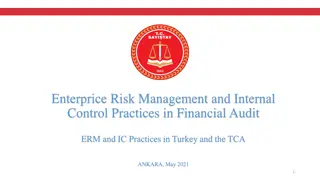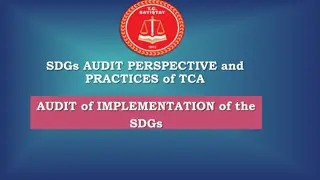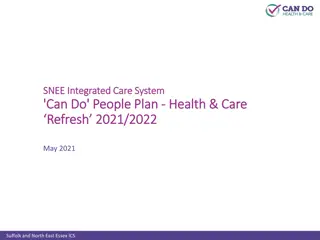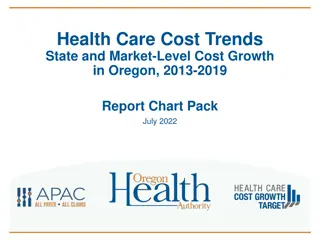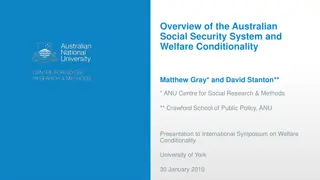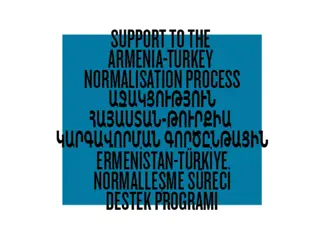Overview of Social Security and Health Care System in Turkey
The social security system in Turkey comprises three main organizations: Social Insurance Institution (SGK/SSK), Social Security Institution for the Self-employed (Bag-Kur/SISE), and Pension Fund for Civil Servants (Emekli Sandigi). Hospitals in Turkey are dispersed among various social security and hospital systems. In 2005, these institutions were unified under the Social Security Institution (SSI), laying the groundwork for the General Health Insurance and Green Card programs, covering needy and uninsured individuals. SGK/SSK (formerly SSK) provides social security coverage for private sector and blue-collar public sector workers, offering benefits for work injuries, medical care, disability, and more.
Download Presentation

Please find below an Image/Link to download the presentation.
The content on the website is provided AS IS for your information and personal use only. It may not be sold, licensed, or shared on other websites without obtaining consent from the author. Download presentation by click this link. If you encounter any issues during the download, it is possible that the publisher has removed the file from their server.
E N D
Presentation Transcript
Health Health Care Care in in Turkey Turkey Prof.Dr.H.Hami OZ
The social security system in Turkey is composed of three different major organizations; Social Insurance Institution (SGK/SSK) SSI/SSA Social Security Institution for the Self-employed (Bag- Kur/SISE)(Soc. Ins. Agency of Self Employed (SISE), Pension Fund for Civil Servants (Emekli Sandigi) PCS /PFCS
Hospitals Dispersed and fragmented social security and hospital system SISE patient SISE/SSK Hospitals Teachers Hospital Police Hospital RailwayWorkers Hospital Postal TelegraphWorkers Hospital SSA patients MoH Hospitals PCS patients University Hospitals Military patients Military Hospitals Private Hospitals
Unification of dispersed and fragmented social security systemAll social security institutions Soc. Ins. Agency of Self Employed (SISE), Pension fund of Civil Servants(PCS) and Social Security Institution (SSI) united under SSI(2005), and became infrastructure to Genaral Health Insurance, Green Card as an instrument of Social Policy covered needy and uninsured people from catastrophic health expenditures. (Some of members will be transferred to GHI with an income test)
SGK/SSK 4A SGK/SSK 4A SGK (formerly known as SSK) is a social security organization for private sector and blue-collar public sector workers. The law entitles all persons who are employed by a contract of service to benefit from social insurance and health care. Agricultural workers, Self-employed, and Persons contributing to one of the pension funds established by law are excluded from the coverage of the SGK. Ministry of Health can do special contracts with University and Private hospitals in order for their members to use such hospitals besides the SGK hospitals. There are co-payments on medical drugs for outpatients; retired pay 10% and employed pay 20%.
SGK/SSK 4A SGK/SSK 4A SGK members are insured for work injuries and professional job diseases, medical care, illness, disability, and maternity. When the insured person paid all his/her contributions for a specified period and have reached a specified age, they're entitled for OldAge Pension. If the insured person dies, widow, children, or close parents of the deceased are paid for funeral expenses and get his/her Pension payments.
Bag Bag- -Kur 4B Kur 4B This institution covers the self-employed outside the coverage of the Social Insurance (SSK) Law. These would be craftsmen, artisans and small businessmen, technical and professional people who are registered to a chamber or professional association, shareholders of companies other than co-operatives and joint stock companies, and self-employed in agriculture.
Bag Bag- -Kur 4B Kur 4B Members of Bag-Kur can choose the step at which they make their contributions between scales of 1 to 24, being 1 the lowest premium payment level with certain medical care limits. They are covered for all outpatient and inpatient diagnosis and treatment. Bag-Kur does not operate its own health facilities, but contracts with other public providers, including the SSK hospitals. Therefore the patient pays for the medical expenses and than get reimbursed by Bag-Kur. Pensioned members have to pay 10%, and active members and their dependants pay 20% of drug costs.
Emekli Emekli Sandigi Sandigi 4C This is a Government Employees Retirement Fund for retired civil servants, it also includes health insurance. Retired Government employees pay only a 10% co-payment for medical drugs and all the rest for their health care is paid by this Fund. There is no specific health insurance premium collected from active civil servants therefore this Fund has huge expenditures with very little control on it, it's completely financed by Government allocations only, causing a big gap in the Ministry's budget.
Green Green Card Card System System The Green Card system was established in 1992 and is directly funded by the Government. Poor people earning less than a minimum level of income which is defined by the law, are provided a special card giving free access to outpatient and inpatient care at the state and some university hospitals, and covering their inpatient medical drug expenses but excluding the cost of outpatient drugs. The expenditure for the almost 11 million Green Card holders has exceeded Government allocations thus causing big gaps in the budget. Only the Ministry of Health is authorized to issue Green Cards.
Other Other Health Health Services Services Private health insurance is well developed inTurkey. Many people pay their premium to private companies besides their regular contribution to state insurance systems, in order to get a better quality health service if they're ill. Also private pension funds (known as BES) have been started some years ago and growing very fast. These private funds are usually private banks or big insurance companies that offer this service. Depending on the pension plan you choose, after 10 - 15 - 20 years you can get an accumulated bonus when you retire from these private funds or get your monthly pension until death.
Other Other Health Health Services Services There are many pharmacies all overTurkey (Eczane inTurkish) which are concentrated especially near hospitals but also in every neighborhood. Certain drugs are sold with green or red prescriptions permitting the Ministry to control sale of some medicines, and there are also many sold over the counter (OTC) without the need of a prescription.
Red Crescent The Red Crescent (Kizilay), equivalent of the Red Cross, is a humanitarian aid organization and covers the widest range of welfare services inTurkey, especially in times of war or natural disaster such as earthquakes.
Health Health Transformation Transformation Program (HTP) Program (HTP) TransformingTurkey's Health System Lessons for Universal Coverage
Health Health Transformation Transformation Program (HTP) Program (HTP) In 2003, Turkey embarked on ambitious health system reform to overcome major inequities in health outcomes and to protect all citizens against financial risk. Within 10 years, it had achieved universal health coverage and notable improvements in outcomes and equity.
Health Health Transformation Transformation Program (HTP) Program (HTP) Health insurance was introduced in Turkey in 1945, at first covering blue-collar workers and later other groups. From 1960 onward, Turkey's 5-year development plans included universal health coverage as an objective; a new constitution in 1982 guaranteed rights to health insurance and health services; and a 1987 Basic Law on Health aimed to operationalize these rights. But the law wasn't implemented, universal coverage failed to materialize, and the poor and unemployed remained without effective coverage
Health Health Transformation Transformation Program (HTP) Program (HTP) Although the Green Card scheme was introduced in 1992 to cover low-income households, it wasn't integrated with existing insurance schemes and lacked a system for identifying potential beneficiaries; moreover, it provided limited financial assistance for inpatient care and none for outpatient consultations, diagnostic tests, or medicines; uptake was therefore low.
Health Health Transformation Transformation Program (HTP) Program (HTP) Battling economic instability, rampant inflation, rising unemployment, and a dissatisfied public, successive coalition governments between 1990 and 2002 did not prioritize health coverage and services. TheTurkish health system faced insufficient and inequitable financing, a shortage and inequitable distribution of physical infrastructure and human resources, disparate health outcomes, and public dissatisfaction.
Health Health Transformation Transformation Program (HTP) Program (HTP) Then, in 2002, a new political party won a parliamentary majority and created a government committed to economic and social reforms. In 2003, it introduced a HealthTransformation Program (HTP) that aimed to improve public health, provide health insurance for all citizens, expand access to care, and develop a patient-centered system that could address health inequities and improve outcomes, especially for women and children. The 2003 Directive on Patient Rights defined citizens' rights to health insurance and choice of health care providers. It codified providers' obligations regarding information provision, confidentiality, and patient consent for interventions and established systems for citizens to express their views about health services.
Health Health Transformation Transformation Program (HTP) Program (HTP) Health reforms introduced between 2003 and 2010 separated policymaking, regulatory, financing, and service-provision roles: the Ministry of Health would focus on policy and strategy development, while other agencies oversaw public health and delivery of personal health services. The Social Security Institution was established as a single payer, pooling both risk and funds from contributory health insurance and the government-financed Green Card scheme; it was responsible for strategic purchasing from providers, and its mandate was to improve service quality and efficiency.
Health Health Transformation Transformation Program (HTP) Program (HTP) The introduction of the HTP coincided with a period of sustained economic growth, which enabled the government to increase health expenditures at an average annual rate of 9.1%. Public-sector funding increased from 63.0% of total health expenditures in 2000 to 75.2% in 2010, the highest in the E7 group of countries with emerging economies including Brazil (47.0%), China (53.6%), India (29.2%), Indonesia (49.1%), Mexico (48.9%), and Russia (62.1%) while health expenditures rose from 4.1% of the gross domestic product in 2002 to 6.1% in 2010.
Health Health Transformation Transformation Program (HTP) Program (HTP) In 2004, Green Card benefits were expanded and new mechanisms introduced to identify potential beneficiaries. In 2006, the Social Insurance and General Health Insurance Law was ratified, though a court challenge by theTurkish MedicalAssociation and medical professionals' unions resulted in amendments and delayed implementation.
Health Health Transformation Transformation Program (HTP) Program (HTP) Between 2008 and 2012, Turkey's various insurance schemes were transferred to the newly established Social Security Institution and merged to establish general health insurance with a unified risk pool and a harmonized benefits package covering preventive health care and family medicine services (provided free at the point of delivery) plus targeted health promotion and prevention programs.
Health Health Transformation Transformation Program (HTP) Program (HTP) Between 2003 and 2011, the number of Green Card beneficiaries increased from 2.4 million to 10.2 million 13.8% of the population, including more than 60% of those in the lowest income decile (a further 24% of the lowest-decile population was covered by contributory health insurance). Insurance coverage also improved in all other income deciles, and 85 to 96% of people in the top deciles were covered by contributory health insurance by 2011.
Health Health Transformation Transformation Program (HTP) Program (HTP) Simultaneously, health services expansion was made possible by increasing the size of the workforce; improving its distribution by means of compulsory service, higher remuneration, and contracting; scaling up primary care services; strengthening emergency medical services; and enabling insured people (other than Green Card holders) to choose private-sector providers.
Health Health Transformation Transformation Program (HTP) Program (HTP) Family medicine centered primary care was introduced in 2005. By 2011, the Ministry of Health had contracts with 20,000 new family medicine teams at 6250 centers, providing expanded primary care services including prevention, women's and pediatric health care, mobile health care for rural residents, and home care for the homebound The number of primary care visits increased from 74.8 million in 2002 to 244.3 million in 2011.
Health Health Transformation Transformation Program (HTP) Program (HTP) Hospital capacity was expanded from fewer than 2.0 acute care beds per 1000 population in 2000 to 2.6 per 1000 in 2011. By 2010, the Social Security Institution had contracted with 421 private hospitals (90% of large hospitals) to provide diagnostic and curative care and complex emergency services such as burn care, intensive care, cardiovascular surgery, and neonatal care. Hospital visits, including inpatient admissions, increased from 124.3 million in 2002 to 337.8 million in 2011, even as active purchasing by the Social Security Institution drove efficiency gains by establishing tariffs for paying hospitals, reducing the average length of stay from 5.8 days in 2002 to 4.1 in 2010, and improving occupancy from 59.4% in 2002 to 65.6% in 2011.5
Health Health Transformation Transformation Program (HTP) Program (HTP) Utilization of maternal and child health services and child mortality improved significantly between 2003 and 2008, especially among rural and socioeconomically disadvantaged populations. Meanwhile, provision of free health care services for costly interventions and reduced cost sharing lowered out-of- pocket and catastrophic expenditures. And satisfaction with health services grew from 39.5% in 2003 to 75.9% in 2011.4
Health Health Transformation Transformation Program (HTP) Program (HTP) Several factors contributed to this transformation. Turkey's population was receptive to reforms that promised health rights and better, more accessible care, and such popular legitimacy helped to overcome the medical profession's resistance. Newfound political stability had invigoratedTurkey after 20 years of ineffective governing coalitions, and the new government's absolute majority in the Grand NationalAssembly permitted swift development and implementation of legislation and policies. Economic growth and a broadened tax base providedTurkey's government with the means to expand its noncontributory insurance scheme, while rising employment levels helped increase coverage through contributory health insurance.
Health Health Transformation Transformation Program (HTP) Program (HTP) In addition, sustained support from the Council of Ministers helped to overcome opposition from medical professionals and the civil service. And a committed transformation team led by the health minister provided continuity and strategic direction for the HTP, mobilized provincial leadership, and addressed implementation challenges as they arose.
Health Health Transformation Transformation Program (HTP) Program (HTP) Turkey's experience offers five key lessons. First, universal health coverage may be best achieved through comprehensive improvements combining demand-side changes (health insurance) with supply-side changes (increased human resources and strong primary care). Second, reforms should be carefully sequenced, with flexible implementation informed by public receptivity to change. InTurkey, major policies were implemented when the sociocultural, economic, and political contexts were favorable, and tactical changes, such as reduced copayments and expanded choice of providers, were used to improve users' experience of the health system, increasing their satisfaction and support.
Health Health Transformation Transformation Program (HTP) Program (HTP) Third, implementation is facilitated when the transformation team works closely with field coordinators, who oversee day-to-day operations and gather real-time intelligence to rapidly address implementation bottlenecks by refining the scope, speed, and sequence of reforms. Turkey's transformation team drew on international experience and collaborated with agencies including the World Bank, theWorld Health Organization, and the Organization for Economic Cooperation and Development.
Health Health Transformation Transformation Program (HTP) Program (HTP) Fourth, it's important to focus on improving the system's responsiveness to citizens; public support provided legitimacy forTurkey's reforms and helped to overcome opposition. And fifth, swift policy formulation and decision making and carefully sequenced implementation can fend off organized opposition and bureaucratic resistance to reform.
MYOCARDIAL INFARCTION MYOCARDIAL INFARCTION A 55-year-old man with no other serious health conditions has a moderately severe myocardial infarction. Chest pain and breathlessness develop during the day in Mr. zt rk, a civil servant who lives in a large city. His family calls an ambulance, which arrives within 10 minutes. He is assessed by the paramedical staff and stabilized with oxygen and painkillers. His electrocardiogram indicates a myocardial infarction. He is taken to the nearest public university hospital, which is able to administer 24/7 primary percutaneous coronary intervention (PCI) within 60 minutes after a patient with a heart attack arrives at the hospital. Mr. zt rk is assessed in the emergency department and transferred to the cardiology unit for coronary angiography and PCI in two coronary arteries and a stent in one.
MYOCARDIAL INFARCTION MYOCARDIAL INFARCTION His recovery is uncomplicated, and the results demonstrated on echocardiography are not considered worrisome. Mr. zt rk is discharged from the hospital after 2 days and is referred to a cardiac rehabilitation program at the hospital.
MYOCARDIAL INFARCTION MYOCARDIAL INFARCTION His hospital costs and the three new medications that he receives on discharge an anticoagulant, a beta-blocker, and a statin are covered fully by the Social Security Institution. He makes an appointment the following week to see his family physician and to receive a repeat prescription for the medicines, for which he pays 20% of the cost. He is seen in the university hospital outpatient clinic 6 weeks after his discharge, for which he incurs a small cost.
PREGNANCY AND CHILDBIRTH PREGNANCY AND CHILDBIRTH A healthy 23-year-old woman is pregnant for the first time. Ms. Kaya and her family have recently enrolled in the Green Card scheme and registered with the new family medicine center when she discovers that she is pregnant. At the center, Ms. Kaya meets a nurse and the family doctor and receives advice on family planning, healthy nutrition, exercise, and risks associated with tobacco and alcohol use. During this visit, her pregnancy is confirmed.
PREGNANCY AND CHILDBIRTH PREGNANCY AND CHILDBIRTH In her first antenatal consultation, Ms. Kaya has her history taken; a general physical check; measurements of height, weight, and blood pressure; abdominal examination to determine the size of the uterus; and a hand-held Doppler test to assess the fetal heart rate. She has a urine examination for bacteria and protein and blood tests for hemoglobin, ferritin, and hepatitis B. Ms. Kaya also receives tetanus toxoid booster and vitamin D supplements. She is provided with general advice on pregnancy and referred to the new mother-friendly hospital for an ultrasound, which proves to be normal. Ms. Kaya has three further antenatal clinic visits and receives iron supplements. Her delivery at the hospital is uneventful.
PREGNANCY AND CHILDBIRTH PREGNANCY AND CHILDBIRTH Ms. Kaya has postnatal checks for herself and the baby before being discharged home 24 hours after delivery. During the 6-week postnatal period, she receives four home visits by the family nurse; at the first visit, the baby is given a heel-prick test for phenylketonuria, congenital hypothyroidism, and biotinidase deficiency. Ms. Kaya receives continued support for breast-feeding and checks for postpartum depression. The baby is registered in the family health center and receives, according to schedule, immunizations for 11 conditions.
Turkish Turkish healthcare healthcare and as a as a foreign and medical medical system foreign national national system The Ministry of Health is in charge of all health services in Turkey. Turkey is a strong competitor in healthcare when compared with other countries such as; the US, Germany, and England are a few. The current statistics showTurkey as a low cost health provider compared to these nations.
Turkish Turkish healthcare healthcare and as a as a foreign and medical medical system foreign national national system Here s an excellent financial example. Let s say you needed a heart bypass surgery: in the US it would cost around $129,750.00, in Germany it would cost $17,355.00, in England it would be $27,770.00. in Turkey a heart bypass surgery would cost you $11,375.00-15,000.00.





